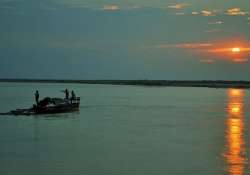China's Reckless Destruction: Dam projects harming river Brahmputra
New Delhi: China is planning at least 20 large dams for the Tsangpo (Brahmaputra) and its tributaries within Tibet. If all go into operation, the river will never be the same again, warns Michael Buckley,

New Delhi: China is planning at least 20 large dams for the Tsangpo (Brahmaputra) and its tributaries within Tibet. If all go into operation, the river will never be the same again, warns Michael Buckley, a Canadian environmentalist who has done extensive research on the subject.
"China claims these dams will have no impact downstream, but the fact is that these dams are just the start of things, with bigger and bigger dams on the drawing-board, such as 800-MW Zhongyu Dam on a Yarlung Tsangpo tributary.” He added.
India has repeatedly expressed concern over the possible impact of damming the Brahmaputra, one of the strongest Himalayan rivers, in upstream areas in Tibet. China has routinely allayed the fears by saying its plans were restricted to run-off-the-river dams focused on generating electricity, which posed little danger
Buckley has also written a book "Meltdown in Tibet: China's Reckless Destruction of Ecosystems from the Highlands of Tibet to the Deltas of Asia" in which he tries to focus on the darker side of China's emergence as a global super power.
Chinese engineers are constructing a five-dam cascade on the mid-reaches of the Tsangpo (Brahmaputra). Zhangmu Dam, with a capacity of 540 MW, has already started operation. The dam lies 86 miles southeast of Lhasa. Construction is under way on the other dams in this cascade," he said.
Environmentalists opposed to the project have asked why China wants to disrupt already fragile ecology in the Tibetan region which is in little need for additional electricity because of slow industrial growth.
Buckley also suggests that India needs to stand up to this travesty. "India needs to negotiate water-sharing rights with China (as India has done with Pakistan and with Bangladesh)."
India recently said it will commission extensive studies to study the impact of dam building and behavioral changes in the Brahmaputra. But experts ask if such delayed studies would be useful in the face of Chinese plans to build four more dams on the river.
The Great Bend (in Tibet) of the Brahmaputra from where the river begins its course towards India holds the greatest hydropower potential in the world, says Buckley, who has travelled extensively throughout Southeast Asia, and the Himalayan and Karakoram ranges and has made a documentary on major environmental issues in Tibet.
A huge dam at the Great Bend would devastate the river's fragile ecosystem - destroying the magnificent biodiversity of the Assam and Himachal Pradesh region. This is much more than a question of water coursing into India: a huge dam would withhold the river's sediment from the fertile floodplains of Assam and Arunachal Pradesh.
(With inputs from PTI)